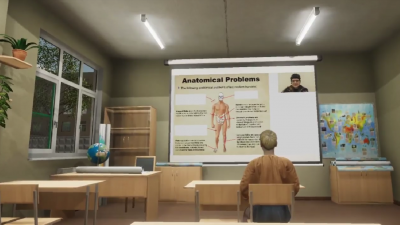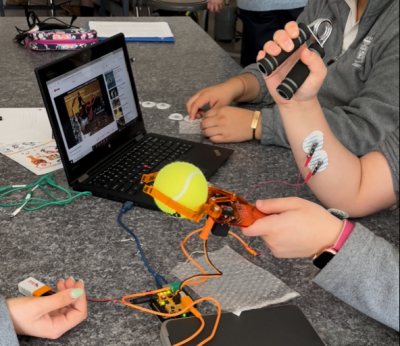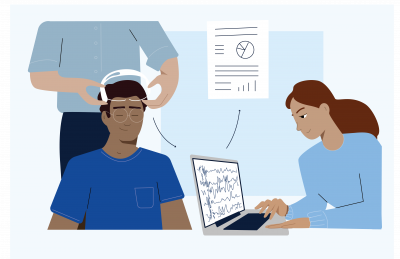The Lab-to-Classroom research group conducts research at the intersection of neuroscience, cognitive science, psychology, and education. We are interested in how educators and researchers can work together to improve education. You can find out more about our current research projects below, and please contact us if you would like to be involved.
BrainWaves: Measuring EEG Brain Activity in the Classroom
Neuroscience is one of the most rapidly growing STEM fields, with increasing presence in public media and potentially important implications to everyday life (e.g. education, medicine and law). However, brain science is not typically incorporated into K-12 science education, and students’ basic knowledge about the brain remains fragmentary. The BrainWaves program, funded by a Science Education Partnership Award (SEPA) from the National Institute of General Medical Sciences, is a lab-based brain science experience, where students learn to design and carry out original brain experiments using real brainwave scanning equipment in the classroom. Our goal is to provide an opportunity for students to get first-hand experience with the scientific inquiry process through the use of professional lab-standard equipment and the development of unique experimental designs that enable the investigation of students’ individual interests.
For more information, visit the BrainWaves website

Virtual Reality Classroom
Over the years educational institutions have witnessed a gradual shift to online modes of learning, a trend which was further accelerated due to the pandemic. As a result, understanding how students and instructors engage within online learning environments has emerged as a timely and important topic of investigation. Most prior research on student engagement relies heavily on self-report data, which poses several methodological and conceptual issues. Moreover, most studies on student engagement are conducted in an artificial lab setting which is far removed from the challenges encountered in real-world classrooms. Given these limitations, our project aims to integrate the use of an immersive virtual reality classroom environment and behavioral, eye gaze, and EEG data to investigate the engagement and learning of undergraduate students.The virtual reality classroom has been designed and programmed using Unity with teacher and student avatars and the classroom scene which participants can interact with using the VR headset and controllers. Findings from this line of inquiry can inform the design of future novel evidence-based instructional methods that leverage the unique benefits of a virtual reality learning environment. Moreover, this project will support the design of instructional technologies that can be tailored to the needs of individual students and promote education equity by supporting students who might not thrive in traditional classrooms

Fostering Computational Thinking Through Neural Engineering Activities in High School STEM Courses
There is a critical need to incorporate Computational Thinking (CT) into K-12 science education to reflect the increasingly computational nature of STEM fields and to prepare students for STEM careers. However, most existing CT education efforts focus on programming and computer science courses, which are only offered at 45% of US high schools. This represents a missed opportunity because these courses are not accessible to all students, especially those from underrepresented groups in STEM. In this NSF-funded project, we explore how CT and engineering design can be incorporated into a core biology high school course and how to increase equitable access to STEM by integrating CT into the core biology curriculum. We develop and evaluate (both formative and summative) a neural engineering unit—an emerging field that integrates neuroscience, engineering design, and programming—implemented in ninth/10th-grade core biology courses and examine the changes in students’ CT, engineering design processes, and attitudes towards STEM throughout their participation in the unit. We also develop and implement professional development workshops for teachers and examine how their participation in the PDs and unit implementation shape their self-efficacy for fostering CT in their students.

The Role of Internal Attention in Science Learning
In undergraduate STEM college courses, students are often required to focus their attention on a single object, such as an online lecture, for a long period of time. This can be an extremely taxing task since attention is dynamic and tends to fluctuate between external (what is happening in the lecture, and the room around the student) and internal states (what the student is thinking, whether on-task or off-task). While external attention has been studied extensively, very little is known about the functional significance of internal attention - the selection and modulation of internally generated thoughts - and how internal attention might affect college-level learning in online environments. To address this gap in our understanding, we are carrying out an NSF-funded study to investigate how varying types, durations and frequencies of internal attention (“thinking”) periods presented during an online biology lecture may promote or hinder student learning. While students watch these online lectures, we use electroencephalography (EEG) to identify neural signatures of attention fluctuations during biology learning, and develop course-based undergraduate research experiences where biology students investigate their own attention states and associated brain activity by wearing portable EEG devices and analyzing their own neural signatures.

Brain Healthy: Engaging Students in Citizen Science Brain Health and Wellness Investigations to Promote Data Science Literacy
Brain Healthy, funded by a Science Education Partnership Award (SEPA) from the National Institute of General Medical Sciences is an educational brain health and wellness program, which will be implemented in 9th and 10th grade biology or health science classes. It is designed by a multidisciplinary team across the University of Connecticut and New York University in partnership with public school teachers in Connecticut and New York City that primarily serve students from underrepresented racial/ethnic groups in Science, Technology, Engineering, and Mathematics (STEM). Students in the program will participate in a large-scale “citizen science” research project, and then gain access to the database to investigate their own research question related to brain health and wellness.
Three cohorts of 10 teachers will be recruited, each participating for three years, and across the 5- year project, ~1500 students are expected to participate in Brain Healthy.
For more information, visit the Brain Healthy website
Contact Us
Have a question? Want to suggest an idea for a research project? Please feel free to reach out to the Lab-to-Classroom team.
